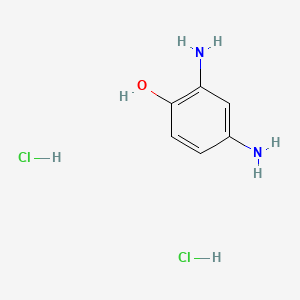D0644 | 2,4-diaminophenol dihydrochloride
| Toxicity | Dose | Time | Species | Model | Method | Action | Positive criterion | Reference |
|---|---|---|---|---|---|---|---|---|
| MEMBRANE POTENTIAL | 3.77±1.06 | human | qHTS-HepG2 | MMP assay | decrease | IC50 | 163 | |
| MEMBRANE POTENTIAL | human | HepG2 | MMP assay | Negative | IC50 | 163 | ||
| MEMBRANE POTENTIAL | rat | hepatocytes | MMP assay | Negative | IC50 | 163 | ||
| Pictogram | Signal | Statements | Precautionary Statement Codes |
|---|---|---|---|
   |
Danger |
Aggregated GHS information provided by 50 companies from 8 notifications to the ECHA C&L Inventory. Each notification may be associated with multiple companies. H301 (96%): Toxic if swallowed [Danger Acute toxicity, oral] H315 (94%): Causes skin irritation [Warning Skin corrosion/irritation] H317 (14%): May cause an allergic skin reaction [Warning Sensitization, Skin] H319 (94%): Causes serious eye irritation [Warning Serious eye damage/eye irritation] H334 (14%): May cause allergy or asthma symptoms or breathing difficulties if inhaled [Danger Sensitization, respiratory] H335 (94%): May cause respiratory irritation [Warning Specific target organ toxicity, single exposure Respiratory tract irritation] Information may vary between notifications depending on impurities, additives, and other factors. The percentage value in parenthesis indicates the notified classification ratio from companies that provide hazard codes. Only hazard codes with percentage values above 10% are shown. |
P261, P264, P270, P271, P272, P280, P285, P301+P310, P302+P352, P304+P340, P304+P341, P305+P351+P338, P312, P321, P330, P332+P313, P333+P313, P337+P313, P342+P311, P362, P363, P403+P233, P405, and P501; (The corresponding statement to each P-code can be found at the GHS Classification page.) |
  |
Danger |
H301: Toxic if swallowed [Danger Acute toxicity, oral] H373: Causes damage to organs through prolonged or repeated exposure [Warning Specific target organ toxicity, repeated exposure] |
P260, P264, P270, P301+P310, P314, P321, P330, P405, and P501; (The corresponding statement to each P-code can be found at the GHS Classification page.) |
| 137-09-7 | 2,4-DIAMINOPHENOL DIHYDROCHLORIDE | 2,4-DIAMINOPHENOL DIHYDROCHLORIDE (SEE ALSO 2, 4-DIAMINOPHENOL HYDROCHLORIDE29849-01-2); |
| 2,4-Diaminophenol 2HCl | 2,4-Diaminophenol HCl | 2,4-Diaminophenol dihydrochloride, 98% |
| 2,4-Diaminophenol hydrochloride | 2,4-Diaminophenol.2HCl | 2,4-diamino-phenodihydrochloride |
| 4-Hydroxy-m-phenylenediammonium dichloride | AC-24480 | ACMC-209txe |
| AK-58684 | AKOS009031621 | ANW-43056 |
| Acrol | Amidol | CAS-137-09-7 |
| CCRIS 2118 | CHEMBL3181794 | CTK3J4706 |
| D0080 | D0110 | DB-042375 |
| DS-1956 | DSSTox_CID_401 | DSSTox_GSID_20401 |
| DSSTox_RID_75564 | DTXSID9020401 | Diamidophenol hydrochloride |
| Dianol | EBD2201934 | EINECS 205-279-4 |
| F0001-2429 | FT-0622270 | HSDB 4363 |
| KQEIJFWAXDQUPR-UHFFFAOYSA-N | KS-00000Z7T | KSC494O0N |
| LS-801 | M-4224 | MCULE-6792543196 |
| MFCD00012979 | NCGC00256333-01 | NCGC00258800-01 |
| NCI-C60026 | NSC 1536 | Phenol, 2,4-diamino-, dihydrochloride |
| Phenol, 2,4-diamino-, hydrochloride (1:2) | Q27289548 | RTR-004949 |
| SC-77664 | SCHEMBL1884352 | ST2409071 |
| ST50407023 | T1IYY101NX | TR-004949 |
| Tox21_201248 | Tox21_303017 | UNII-T1IYY101NX |
| W-108243 | Z1262254375 |
| CAS Number | 137-09-7, 6632-58-2 |
| PubChem Compound | 8715 |

